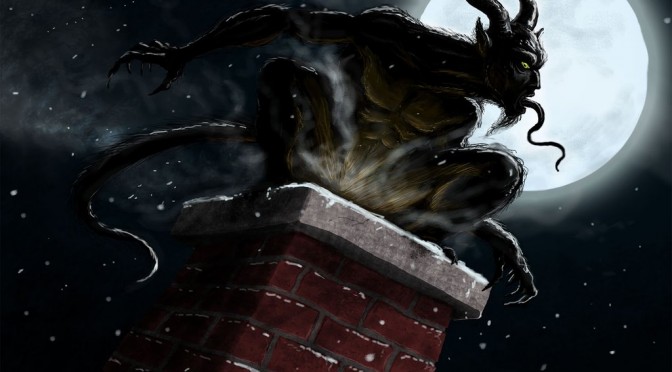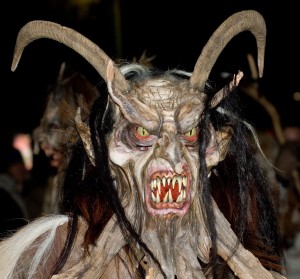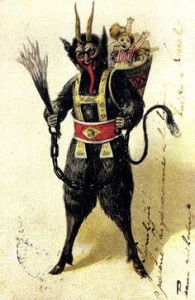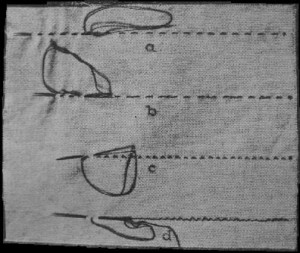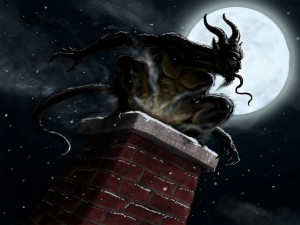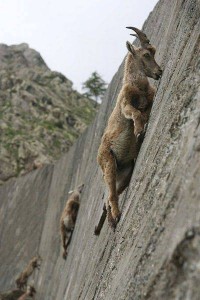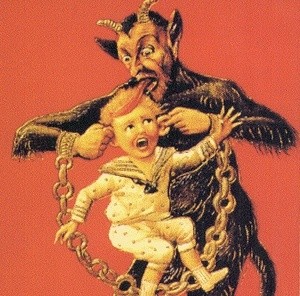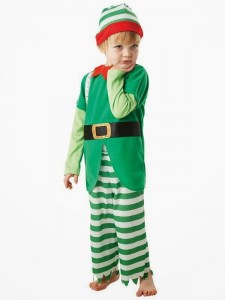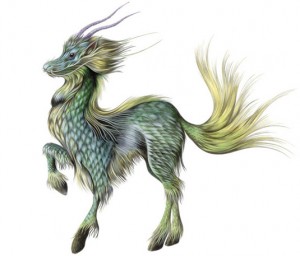In the Alters’ World (and the series of books found here), creatures of legend reveal themselves to the world. Born through genetic abnormalities, defects and mutations, the Alters have lived for centuries as outcasts of human society, hiding their true nature from the world while colorful stories have been written by many to describe what they’ve seen. How are these creatures different from what was described in the stories? What relationship do they have with humanity? Every entry of the Alterpedia will delve into a new creature from around the world. This week we cover:
Krampus
As the Holiday Season comes to a close, one figure has received some harsh treatment by those who know his name. Krampus, the dark companion of Saint Nicholas, is known throughout many countries as a figure of terror for “bad” children. Carrying sticks or whips to beat wicked children and a bag to potentially carry them off to some terrible place, the Krampus is the stick to Saint Nicholas’ carrot.
But is this reputation deserved? Have Krampuses really been tormenting children unprovoked as a jolly man laughs in the corner? Or is this just a case of propaganda being used to keep an underrepresented class in check?
Appearance
Mythology
The Krampus is a demonic entity with monstrous horns, claws, and teeth. Disheveled, he wears old ratted clothes over thick, matted brown or black fur. He has cloven hoofs, and his horns are those of a goat, like that of a Satyr or just the devil himself. Often baring his teeth or glaring at the people he encounters, his long pointed tongue often lolls out.
On his back he carries a variety of tools for punishing the wicked children of the world. Of these tools, a noticeable item is that of a bundle of birch branches which he is said to carry with him to beat children with. Sometimes these branches are replaced with more conventional means such as whips or canes. Regardless of the object, the whipping tool will be present over one shoulder as the other shoulder holds a burlap sack or a washtub large enough to fit small children.
This sizing is not coincidence.
He is also often seen wearing chains, supposedly put there by the Christian church to bind the wicked thing. He shakes these chains for dramatic flare, scaring people with the rattling sound and making intimidating gestures with them. Sometimes, ti amplify this sound, he is also known to put bells on these chains, making it impossible to miss the jingling sounds he makes.
Alters
Living in colder climates of Northern Europe, a Krampus is naturally hairier than the average human. Their fur is often well cared for when they are among civilized people, often trimmed along the face to take the appearance of beards and covered anywhere else as to not draw attention to themselves. The fur ranges all the natural human hair colors, some even being bright white in older age, others known to be a fiery red in color. Their clothes are often a bit less well crafted than the clothes of those around them as they tend to collect these via acts of charity or sew them by hand in the wilderness.
Their goat-like features are, in fact, quite true. Like their cousins to the south, the Satyrs and Minotaurs, they have digitigrade legs with thick toenails which could be mistaken for hooves from a distance. This is not at all like actual goat-legs as goats are unguligrades and feature actual hooves. Their horns, similarly, are not constructed in the same fashion as goat horns, but rather are of a similar composition to those of a deer’s antlers. As a means of fitting in (and to make fashion statements), these horns are often shaved down or carved to make them either unnoticeable or decorative. In a pinch, much like a deer’s antlers, these horns can even be shed and will naturally do so once a year before entering a rapid state of growth in the summer.
Like the mythology, a Krampus is very likely to be carrying birch branches with it. Unlike the mythology, these branches are carried in the sack. The size of the sack is entirely coincidental.
Some Krampus are, in fact, chained. During the early expansion of Christianity, it was common for missionaries traveling through the north to encounter a Krampus, assume it was demonic, and bind it with chains as a means of controlling it. Though few people encounter a Krampus in this same fashion in the modern day, the chains remain for cultural reasons as the Krampus people wear them to represent a tie to their history.
Talents
Mythology
Like Santa Claus and his various incarnations, the Krampus is capable of traveling at incredible speed and being in many places seemingly at once. The speed that they travel is unknown, but their near omnipresent nature indicates they may be able to simply teleport from location to location at will.
An additional point of evidence to this is the fact that the Krampus, like Santa Claus, are able to enter homes that are otherwise closed. Though the stories have never spoken in depth of the Krampus’ activities, it can be assumed from his association with Saint Nicholas and other variations on that figure that the Krampus also employs openings such as chimneys to enter homes in the dead of night – squeezing through spaces otherwise impossible by mortal beings.
After entering the home, however it may do so, the Krampus is then known to be able to seek out wicked children and know their crimes. This may either be through an omniscient power or the ability to read minds, but by either method it would seek out the naughty children as his companion Santa would find the good children. Lying to the Krampus would, of course, be impossible – and likely to cause more severe punishment such as using that supposed teleportation ability to drag you straight to hell.
Alters
The Krampus people are incredibly nimble. Having strong legs and feet that give them natural traction, they are easily capable of traveling across rough terrain quicker than an average human being. Their false hooves grip hard surfaces easily and allow them to balance on objects which are too narrow for a normal human’s feet while their legs have a natural spring-like motion which allows for great leaps and absorbing impacts from long drops. This allows them to travel from rooftop to rooftop swiftly.
Their ability to enter seemingly closed locations, particularly the myth that they could crawl through chimneys, is inspired by the fact… they completely can. Lacking a true clavicle and instead having a partial clavicle like that of a cat, Krampuses are capable of squeezing through tight spaces with relative ease. Their spines are also amazingly flexible, and many Krampuses have been known to achieve impressive feats of contortion. The current record for tightest squeeze achieved by an adult Krampus was pushing through an opening no more than 12 inches in diameter. Children have been known to go even smaller.
Reports of psychic ability, like those involving Witches, Oracles, and Succubi, are a parapsychic talent involving keen observation skills and the ability to detect chemical changes in their environment. In essence, children with guilty consciences are scared, and Krampuses can smell fear.
Behavior
Mythology
The Krampus is a malicious creature that finds and punishes wicked children. Originally demonic in origin, the chains of the Christian church have put it in servitude of the Church and its morals. Though it is still violent by nature, it only uses violence against those who have committed a sin against the church. Naughty children who have lied, cheated, or stolen, are to be punished by order of the Krampus’ master, Saint Nicholas.
Depending on the severity of the crime, the Krampus has several means of punishment. The first is to simply whip the children with the birch branches it carries with it where ever it goes. After enough swats, the children who have learned their lesson are released and the Krampus goes on its way.
However, for the truly wicked children, the Krampus is known to take these children and spirit them away in the sack or tub hanging on its back. These children are never to be seen again, as the Krampus fully intends to kill them for the crimes they’ve committed. These children are to be drowned, taken to hell, or, if the Krampus is particularly hungry, eaten.
Alters
The first issue with these myths is the fact that the Krampus is actually vegetarian in nature. Evolved to live in cold wilderness and high mountains, Krampuses traditionally eat shrubs, berries, and wood pulp. The birch branches it carries with it are not meant for whipping children, but rather to be eaten as they travel – the inner bark of birch being edible and the sap being spicy and sweet. They are known to chew on these idly for some time, resulting in the rumored sharp teeth that they get from the constant gnawing.
As for their treatment of children, the truth is that many people have encountered a Krampus in a friendly environment – Saint Nicholas himself.
A Greek Bishop of the region now known as Turkey, Saint Nicholas became an active Alter later in his life and began to use his new found skills to travel the rooftops for his gift giving activities. Using his ability to sneak in and doing his best to hide his nature, he became a benevolent figure in the eyes of many and his legend spread throughout the world over time. However, over the course of this, another Krampus abused the stories for his own gain.
Santa Claus, despite often being considered the same person as Saint Nicholas, was actually another Krampus with similar features from further north. This Krampus, operating a shop in the frozen wilderness to the far north, began to kidnap children in the middle of the night – particularly the children of another Alter race known pejoratively as “Christmas Elves”.
The conflation of these two figures has often confused the people, no one willing to believe Saint Nicholas would do such things, and thus the tradition began to be that the Krampus was a second figure while Saint Nicholas and Santa Claus were one and the same. The truth, however, remains that there are two figures who go by the name “Santa Claus”, and these two are drastically different people.
The one known to kidnap children, known within the Alter community as simply “Claus”, has operated a slave labor force for centuries, kidnapping and enslaving Christmas Elves for his own gain. His other aliases have been Father Christmas, Papa Noel, Sinterklaas, Nisse, and Ded Moroz.
If encountered, he is to be considered armed and extremely dangerous. He is a repeat offender, causing grave bodily harm to anyone who gets in his way using whips and chains to assault people who tried to prevent his kidnapping activities. Anyone who sees this man is encouraged to call the police and/or NORAD to encourage them to put a stop to his annual harvesting.
The other figure, known within the community as “Santa” is the original Saint Nicholas himself, a man who runs a shelter for refugees of Claus’ shop. Long known for his charitable acts, Nicholas has continued his work into the modern day. Recently, he has been active in arctic conservation efforts, including the keeping of a reindeer-like species of near extinct Kirin.
Though…none of them fly or have glowing noses.
This confusion has only gotten worse over the centuries, resulting in a great deal of misinformation being spread about the Krampus race and several households accidentally letting down their guard to allow the seemingly jolly Claus into their homes, mistaking him for the more benevolent figure of Santa. And, unfortunately…
All attempts to prosecute have failed to this time.
(And, with that, I bring this season to a close. For those of you who got an eReader this Christmas, I’d like to remind you I write books. If you enjoy these articles and the world they’re based on, give them a read!)


